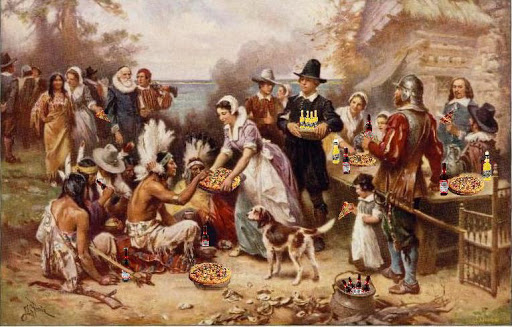Having grown up in a suburb of Boston to third grade, the Pilgrims of Plymouth Colony were bona fide local heroes, right up there with Paul Revere and John and Sam Adams. November activities centered not so much on the saints and Holy Souls, but on retellings and reenactments of the hardships of the Mayflower’s passage, their arrival in Plymouth, the first miserable winter, the friendship and life-saving assistance of Massasoit and Squanto, the abundant harvest, and the menu and games of the harvest festival that is known as the “first Thanksgiving” on U.S. soil in 1621.
This was the stuff of grade school textbooks and was certainly widely accepted by the public. In “Democracy in America,” Alexis de Tocqueville marveled that the very rock on which the Pilgrims set foot as they disembarked from the “Mayflower” had become “an object of veneration in the United States” and “is treasured by a great nation.” Only, of course, Pilgrims first set foot at the tip end of Cape Cod, near present-day Provincetown, Massachusetts and the “Plymouth rock” Americans treasure (now etched with the Pilgrims’ 1620 arrival date) has been widely debunked as their disembarkation pedestal.
Of course there’s nothing wrong with – and much to be gained through – mythic narratives. But even myths are usually based to some extent on truth. And that’s where the “first Thanksgiving” in the territory of the present-day United States falls apart. If, by first Thanksgiving, we mean the earliest occasion where settlers gave thanks to God for their safe arrival (or survival) on the North American continent and celebrated the day with a feast (whether or not shared with Native Americans), then the Pilgrims were late to the game.
The Commonwealth of Virginia asserts its own claim (acknowledged by no less a historian than Harvard’s Arthur Schlesinger, Jr.) for having the first Thanksgiving on U.S. soil on December 4, 1619 – two years before the Pilgrim’s harvest festival. According to the “Richmond Times Dispatch”:
– a year before the Pilgrims arrived at Plymouth.
La Florida, Pedro Menéndez de Avilés, founded the city of St. Augustine – the first permanent European settlement in North America. On that occasion, Menéndez, his countrymen and Native Americans who’d been invited to pray and share a meal with the settlers attended the first Mass on U.S. soil, celebrated by Father Francisco López de Mendoza Grajales. After Mass, the settlers shared a feast with the Native Americans of salted pork, garbanzo beans, biscuits and red wine. The settlers did so in thanksgiving for their safe arrival in the New World and their defeat of French settlers who occupied some of the territory of
La Florida, which (according to the terms of a grant from Philip II of Spain) extended along the U.S. coastline from the Florida Keys to Newfoundland. Odd that the governor of a significant portion of the United States for ten years remains unknown to most Americans.Does it really matter when and where and with whom the first Thanksgiving on U.S. soil was celebrated? Well, sure. The truth matters. But there’s a deeper truth that matters even more. Like these early immigrants, we should be ever aware of God’s actions in our lives, of the big and small blessings he bestows, and always ready to demonstrate our gratitude to God, especially by sharing our joy with others. And today’s a good day to start.
Susan E. Wills is a senior writer for Aleteia’s English language edition.

